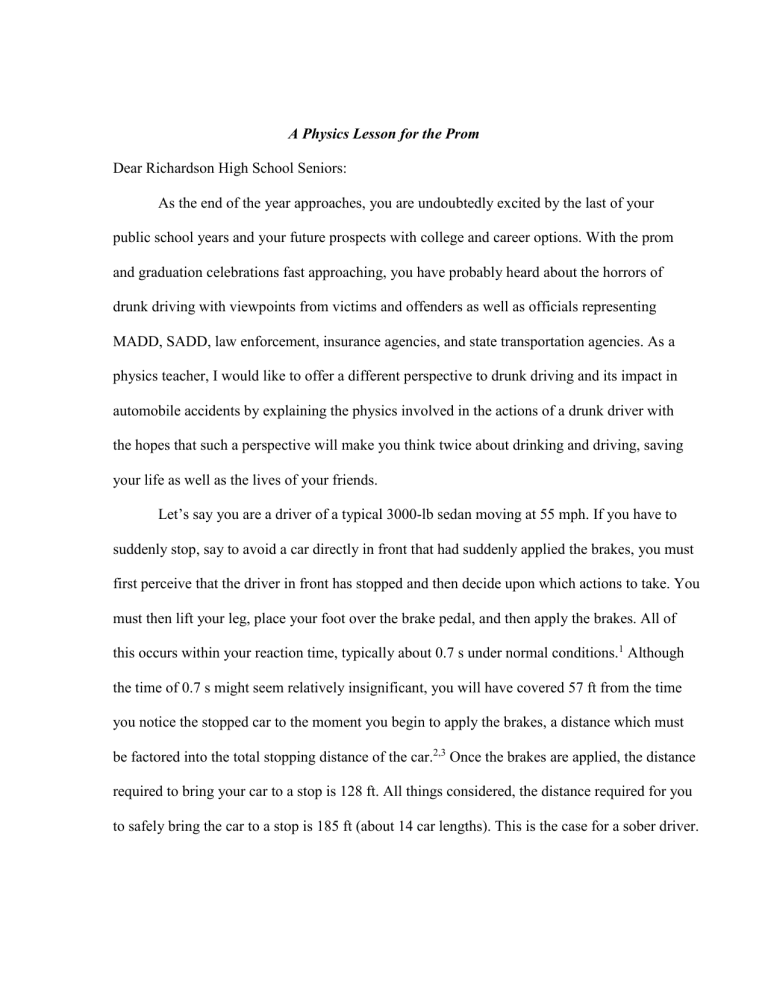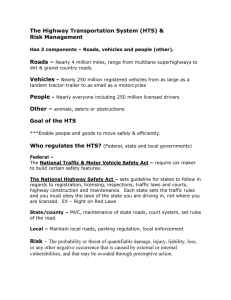A Physics Lesson for the Prom

A Physics Lesson for the Prom
Dear Richardson High School Seniors:
As the end of the year approaches, you are undoubtedly excited by the last of your public school years and your future prospects with college and career options. With the prom and graduation celebrations fast approaching, you have probably heard about the horrors of drunk driving with viewpoints from victims and offenders as well as officials representing
MADD, SADD, law enforcement, insurance agencies, and state transportation agencies. As a physics teacher, I would like to offer a different perspective to drunk driving and its impact in automobile accidents by explaining the physics involved in the actions of a drunk driver with the hopes that such a perspective will make you think twice about drinking and driving, saving your life as well as the lives of your friends.
Let’s say you are a driver of a typical 3000-lb sedan moving at 55 mph. If you have to suddenly stop, say to avoid a car directly in front that had suddenly applied the brakes, you must first perceive that the driver in front has stopped and then decide upon which actions to take. You must then lift your leg, place your foot over the brake pedal, and then apply the brakes. All of this occurs within your reaction time, typically about 0.7 s under normal conditions.
1 Although the time of 0.7 s might seem relatively insignificant, you will have covered 57 ft from the time you notice the stopped car to the moment you begin to apply the brakes, a distance which must be factored into the total stopping distance of the car.
2,3
Once the brakes are applied, the distance required to bring your car to a stop is 128 ft. All things considered, the distance required for you to safely bring the car to a stop is 185 ft (about 14 car lengths). This is the case for a sober driver.
Suppose you have left a party at a friend’s lake house and now have a blood alcohol concentration (BAC) of 0.08 (in Texas, this level constitutes the legal definition of inebriation – equivalent to consuming four to five alcoholic drinks during one hour.) At a BAC of 0.08 and greater, drivers will experience an impaired reaction time. If your reaction time is lengthened to
2 seconds, you will have covered 162 ft before applying the brakes and will need a total stopping distance of close to 290 ft (about 22 car lengths). Compared to a sober driver, the drunk driver requires an additional 105 ft (or 8 car lengths) to bring the car safely to a stop. The more you drink, the greater the reaction time and the more distance you will need to bring the car to a stop.
However, because someone with a BAC of 0.08 or greater will also experience impairment of other important qualities required to drive safely such as vision, judgment and perception, these distances are conservative and a collision with the car ahead seems very likely.
Let’s say that, as you are driving home from the party, the car ahead that seemed like it was 5 miles in front of you is now 5 feet in front of you. In order to avoid a collision, you immediately pull on the steering wheel, veering to the side of the street, jumping the curb and colliding with a tree directly in front of you, still maintaining a speed of 55 mph. It is important to realize that, not only is your car moving at 55 mph, but so are you. Once your car rams into the tree, your car is brought to a stop
but what about you? According to Newton’s First Law of Motion, an object at rest remains at rest and an object in motion remains in motion, unless acted upon by an unbalanced force. In this case, the unbalanced force that brought your car to a stop was the tree. However, nothing has stopped you and so you will continue at 55 mph until you too are stopped by a force – usually when you impale yourself on the steering wheel column and your head slams into the windshield.
So what kind of impact force will you experience as your head slams into the windshield? To cite you a specific value for the impact force is a difficult task primarily because the force depends on the size of the driver, the year, make, model of the car, the presence and location of crumple zones, and the angle of impact of the car. However, remember that you will be thrust toward the windshield at 55 mph. To put this in perspective, the speed that you will strike the windshield is equivalent to the speed that you would strike the ground after being dropped from an 8-story building.
Furthermore, the car moving at 55 mph has a kinetic energy of approximately
300,000 ft-lb which will become zero within seconds, courtesy of the treeIn order to change kinetic energy, work must be done in the form of a force applied over a distance. The larger distance that one has results in a smaller force required to change the kinetic energy.
However, the opposite is the case – because the stopping distance of the car is extremely short, i.e., car collapses about 1 ft from the front grill and an additional 0.2 ft of travel for the chest to reach the steering wheel (total stopping distance is about 1.2 ft). To put this distance in perspective, the distance required for the car originally moving at 55 mph to come safely to a stop is 128 ft. Thus, a significant force will be required to stop your car - on the order of several tons of force. This force does, of course, imply that you are not wearing your seat belt.
“ This won’t apply to me because I use a seat belt and I have airbags in my car. I’ll be
OK
.” While it is true that seat belts, air bags and other vehicle restraint devices can be important in the safety of the driver, it first depends on whether the driver properly uses the seat belt and activates the air bags. Second, even if this is the case, these devices are useful in car crashes typically involving speeds less than 35 mph. The faster the initial speed of the car
prior to impact, the more likely the driver is to sustain severe, possibly fatal, traumatic injuries in an auto accident, regardless of seat belts. Let’s say, for the sake of argument, that after you leave the party, you do think to fasten your seatbelt. So how much of a difference will that make with regard to the impact force that you will experience? Again the speed that you will be moving as you strike the windshield is the same speed attained by a car dropped from an 8-story building. As you are released from an 8-story building on your way toward the ground, how much difference do you think wearing a seatbelt would make as you strike the ground?
Yes, the proper use of seatbelts in a crash does reduce the amount of impact force you experience and of course driving a newer model of car that is equipped with air bags and front-end crumple zones significantly reduces the impact force exerted on the driver.
However, before you are quick to dismiss the gravity of driving drunk at 55 mph because you drive a newer model car equipped with the latest vehicle restraint devices, keep in mind the following statistics from the most recent available year of 2004:
4,5
13.8% of all drivers involved in fatal crashes were young drivers age 15 – 20;
24% of young drivers aged 15 – 20 who were killed in crashes had BAC levels of
0.08 g/dL or higher;
Among young passenger vehicle drivers involved in fatal crashes, 63% of those who
had been drinking were unrestrained; and,
31.5% of drivers involved in single vehicle fatal crashes were going at 55 mph.
“I would definitely survive because I’m so lucky, I’m the star football player, I’m the head cheerleader, or I’m the Homecoming Queen.” Please do not be lulled by a false sense of security and the all too common air of invincibility. Newton’s Laws of Motion apply in every
circumstance, with no one immune from these laws of physics – not the star football player, the homecoming queen, or even a physics teacher! The chances of surviving an automobile accident at 55 mph, just like your chances of surviving a fall from an 8-story building, are very small. If you do somehow survive, remember the following two points: (1) chances are also good that you will have sustained so much trauma and injury such as broken arms/legs; fractured ribs, pelvis, collarbone, or sternum; collapsed lungs; a major concussion; ruptured/severed blood vessels; multiple lacerations, abrasions and contusions; skull fractures; and, abdominal bleeding, that you will probably wished that you hadn’t; and (2) your date or your friends who are passengers in the car may not be as lucky at surviving an accident at 55 mph. Of course, if you’re lucky and skilled enough to survive such an accident that your date or your friends did not, you should not have any trouble explaining your luck to their parents and families.
“Oh, you’re just a stuffy, self-righteous, know-it-all teacher who is trying to tell me what to do.”
First of all, I am not a teacher who is stuffy, self-righteous, and know-it-all. I am a teacher who cares – cares immensely about what happens to you, not only in this class but in school as well as in life. If you think that I took this job of teaching at Richardson High School because of the great pay, short hours, and stimulating meetings, please think again. Secondly, I would never tell you what to do. What I can and will do is educate you on an issue that could potentially have devastating consequences. One thing that you will learn about life, if you haven’t already, is that life is full of choices. I am trying to provide you with as much information as I can so that you can make an informed choice. You are free to make any choice that you prefer but also be prepared to accept the consequences.
The physics described in this letter is relatively straightforward to understand and holds true regardless of the person, the car, the conditions and the circumstances. As a teacher, I usually
encourage my students to learn from experience, not from lecture. For this physics lesson, I will make an exception. It is the most important lesson that I could ever teach. I hope this lecture is good enough to make the point and that one does not have to learn from experience.
On behalf of the entire faculty and staff of Richardson High School, I would like to wish you congratulations on an impressive accomplishment. Have happy and safe prom and graduation celebrations and good luck with all of your future endeavors.
George Hademenos, Physics Teacher
Richardson High School
References
1. M. Green, “How Long Does It Take to Stop?” Methodological analysis of driver perceptionbrake times. Transportation Human Factors 2 (3), 195–216 (2000); Available for download at: http://www.visualexpert.com/Resources/green_transportation_hf.pdf.
2. B.J. Feldman, “Elementary physics in a real automobile accident,”
Physics Teach. 35 , 335-338
(1997).
3. A. Damask, “Forensic physics of vehicle accidents,”
Phys. Today 40 , 36-44 (1987).
4. Traffic Safety Facts 2004 Data. Young Drivers . NHTSA National Center for Statistics and Analysis. National Highway Traffic Safety Administration.
5. Fatality Analysis Reporting System (FARS) Web-Based Encyclopedia; http://www.fars.nhtsa.dot.gov/.



